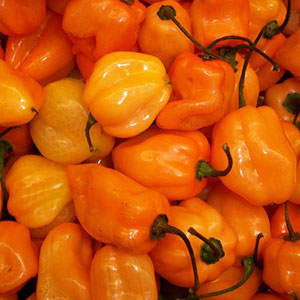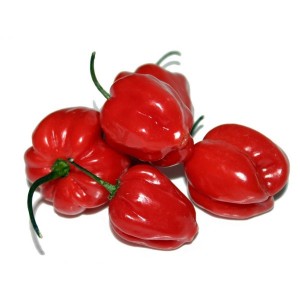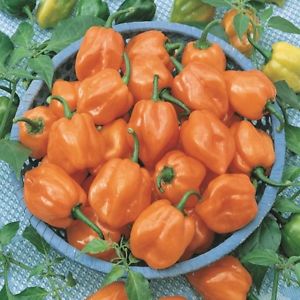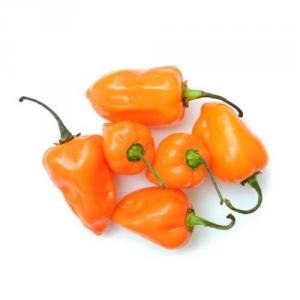How to grow habanero hot peppers and use this component correctly in cooking
Habanero is recognized as one of the hottest chili peppers. Special pungency and pronounced taste are its distinctive features. Initially, this pepper was distributed in Mexico, then they began to export it to China and Europe. Habanero pepper is an essential ingredient in the famous Tabasco sauce.
You can grow an exotic plant at home - on a windowsill or in a greenhouse.
The content of the article
Characteristic
The Scoville pungency scale, named after its developer, an American chemist, is used to characterize the taste of peppers. The scale values are from 0 to 16,000,000,000 units.
Habanero is so spicy that in Scoville units (ECU) it gains 350,000-577,000 ECU, while the famous bell pepper gains only 0-100 ECU.
Reference. The most acute in the world is the Scorpion variety of Trinidad. Its severity on the Scoville scale ranges from 855,000 to 1,463,000 ECU.
In their homeland, Mexico, Habanero pepper is used as a seasoning for cooking national dishes and canning... It contains vitamins A, B, C, D, many minerals (calcium, iron, phosphorus, iodine, potassium).

There are several varieties of the Habanero variety:
- Habanero chocolate;
- Habanero Red Savina;
- Habanero Red Caribbean;
- Habanero Tigerpaw-nr;
- Habanero Fataly;
- Habanero White.
All of them were bred in the USA, South Africa and California. They differ in the level of sharpness, size and color.
Habanero fruits are formed in the form of a small heart weighing 50 g. Up to 90 fruits can ripen on a bush. One plant produces 2-3 kg of burning "hearts".
Spicy lovers who use Habanero claim that there are hints of fruit and citrus in the taste of pepper. You can distinguish it from other species by its delicate floral scent.
Preparation for growing and planting in the ground
Sowing seeds of Habanero peppers begins in late February - early March. But first, the seeds must be laid out on a wet napkin or cloth for three days. On the fourth day, pour soil (earth, humus and peat) into the container where the pepper will be grown and place the swollen seeds to a depth of 0.5-1 cm.
After planting, spray with warm water and create a greenhouse effect with a plastic bag or glass container. Air the sprouts for a few minutes once a week.
By the middle of the third week, the pepper begins to sprout and the artificial greenhouse can be replaced with a fluorescent lamp, which should shine on the sprouts 15-17 hours a day. Leaves appear in the fourth week. Now the sprouts need to be transplanted into separate pots with a volume of 100-200 ml, and the lamp should be raised higher from the shoots and turned on for 10-12 hours.
From sowing to planting in the ground, 2–2.5 months should pass for the seedlings to finally get stronger. Pepper Habanero loves warmth, therefore, it can be planted outside (in a greenhouse) closer to mid-May, when the air and earth have already warmed up enough, and frosts are not expected at night.
Important! The first flowers are cut off from young plants, this will allow the pepper to gain strength for further growth. And already in early October, the first fruits will appear.
If you want to grow pepper on a windowsill in an apartment, then with the right lighting, choice of temperature and sufficient humidity, Habanero pepper can delight you with fruits several times a year.
Pepper propagates by seeds. The ripe fruit is dried, cut and seeds removed. Then the grains are placed in a bag, protected from moisture. On contact with water, the seeds will rot and become unsuitable for planting.
Plant care
During the sprouting of the pepper, it is regularly watered with water at room temperature. Do not fill, as decay may occur. If the pepper grows on the windowsill, water it twice a day, in winter once every two to three days. Mineral fertilizers are used for feeding.
Important! Do not forget to water the plant on time, give it enough light and treat pests.
For consistent fruiting, remove flowers from the plant more often. Pepper also needs sunlight, so at home put it on the lightest window.
On the street, insects cope with the role of a pollinator. But at home, the owner should help the plant with the help of a fluffy brush.
Diseases and pests
Habanero pepper is resistant to the vast majority of diseases... The only pest that the burning plant cannot resist is nematode worms. You can get rid of them with hot water (at least 50–55 ° С).
Carefully remove the bush from the pot or from the soil (if the pepper grows in a greenhouse), peel the roots and place them in a container of hot water for 3-5 minutes. More than 95% of nematodes die after such a procedure. If necessary, repeat the procedure again, but not earlier than after 4 months.
Advantages, disadvantages and applications
How is Habanero pepper useful? As we already know, the variety contains many vitamins and minerals. The use of hot pepper in hair care is popular. Add a couple of drops of juice to the hair mask - this will awaken dormant hair follicles.
Pepper promotes the production of endorphins, lowers blood pressure, and helps get rid of depression. Also, hot pepper is used as an analgesic and antibacterial agent. It is believed that pepper speeds up metabolism, increases stress resistance and slows down the aging process.
Habanero bitter pepper is a powerful aphrodisiac. With prolonged contact with food, he rewards the dish with such a sharp taste that it is almost impossible to eat food.
If you nevertheless ate the Habanero pepper, you should not drink it with water, it is better to drink milk. The casein in milk will work better with capsaicin, the substance that gives the pungency.
But you should be careful: women who are breastfeeding, young children and people suffering from peptic ulcer disease, the use of Habanero pepper is contraindicated. It is also not recommended to eat peppers raw.
Important! Be careful when plucking the fruit from the branch. On the hands of the pepper, bitterness remains, which is difficult to get rid of for several hours.
Few know that Habanero peppers make a useful infusion for watering flowers and plants, which kills ants, bugs and their larvae.
Reviews
We bring to your attention a few reviews of experienced summer residents.
Vita, Costa Rica: «For me, hot peppers have always been just hot. Until then, until I found myself on the continent, where many of its species are home, and in traditional food there is nothing without it. I tried sauces first pickled peppers. The most popular in Costa Rica are Jalapeno and Habanero. Now I cook it myself constantly. One of the hottest in the world, but I love it! "
Svetlana, Liski: “I really like spicy dishes. I grow a lot of hot peppers, but my favorite variety is the yellow Habanero. The fruits taste incredible! Imagine melon-flavored hot peppers! This will be Habanero. I plant it in a greenhouse in the summer, for the winter I put it in a large pots and bring it into the house. All year round I have a burning addition to my favorite dishes. "
Alisa, Ermolino: “I have experience in growing vegetable crops in the beds, I decided to try growing hot peppers on the balcony. I chose Habanero. The fruits are distinguished by their pungency, pronounced peppery taste and aroma. What we liked: simplicity of cultivation, high yield, long fruiting. I collected more than 80 peppers from one bush ”.
Read also:
Dutch hybrid pepper "Gemini f1".
Conclusion
In addition to the spicy taste and sweet aftertaste, the plant also has decorative properties - it will perfectly fit into the home interior. Habanero looks great both on the windowsill in the apartment and on the flowerbed, both in large and in small quantities. At home, pepper bears fruit several times a year and grows up to 9 years.
Fans of spicy dishes can delight themselves without leaving home - it is not difficult to grow Habanero peppers, you just need to observe the watering regime and help the flowers to pollinate. In addition to its use in cooking, Habanero will help in hair care and in the fight against various pests on the backyard.